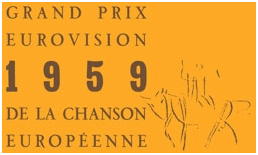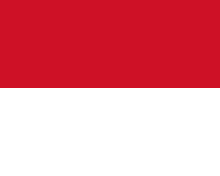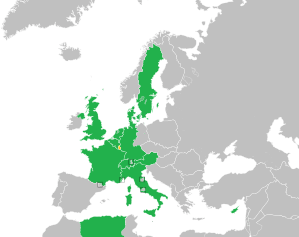Eurovision Song Contest 1959
| Eurovision Song Contest 1959 | |
|---|---|
 | |
| Dates | |
| Final | 11 March 1959 |
| Host | |
| Venue |
Palais des Festivals et des Congrès Cannes, France |
| Presenter(s) | Jacqueline Joubert |
| Conductor | Franck Pourcel |
| Directed by | Marcel Cravenne |
| Host broadcaster | Radiodiffusion-Télévision Française (RTF) |
| Interval act | None |
| Participants | |
| Number of entries | 11 |
| Debuting countries | |
| Returning countries | |
| Withdrawing countries | |
|
Participation map
| |
| Vote | |
| Voting system | Each country had 10 jury members who each awarded 1 point to their favourite song |
| Nul points | None |
| Winning song |
"Een beetje" |
The Eurovision Song Contest 1959 was the fourth edition of the annual Eurovision Song Contest.
It was held on Wednesday 11 March 1959 in Cannes, France, following the country's victory at the 1958 edition.[1] The contest was won by the Netherlands with the song "Een beetje", performed by Teddy Scholten. This was the second win for the Netherlands. Willy van Hemert was also the lyricist of "Net als toen", which won the Eurovision Song Contest 1957.
Location

The event took place in Cannes, France, with the venue being the original building of Palais des Festivals et des Congrès, after France got the right to host this edition of the Eurovision Song Contest for winning its previous 1958 edition with the song "Dors, mon amour" performed by André Claveau. Cannes, a city located on the French Riviera, is a busy tourist destination and known worldwide for hosting the annual Cannes Film Festival, with the Palais des Festivals et des Congrès also hosting the Film Festival. The original building was built in 1949 and was located on the boulevard of Promenade de la Croisette, on the present site of the JW Marriott Cannes.
Format
A new rule was created for this Eurovision, ensuring that no professional publishers or composers were allowed in the national juries. Italy gave one point to France, no points to the UK and seven points to the Netherlands placing them just three points ahead of the UK. Later on France gave only three points to Italy and four points to the Netherlands giving them a five-point lead over the UK, who were only one point ahead of France, leaving Italy behind in sixth position, behind Denmark, on nine points. Something that occurred this year, but never again, was that more than the winning entry was performed once again. The second and third placed songs, United Kingdom and France, were allowed to sing again at the end of the show, together with eventual winner, the Netherlands.
Participating countries
Luxembourg withdrew from the contest for the first time. The United Kingdom returned after missing the previous contest (appearing on the scoreboard as "Grande Bretagne") and finished second for the first time. The UK would have 15 second-place finishes in the country's history in the contest. Monaco made its debut in the contest, but came last.
Conductors
Each performance had a conductor who maestro the orchestra.[2]
-
 France - Franck Pourcel
France - Franck Pourcel -
 Denmark - Kai Mortensen
Denmark - Kai Mortensen -
 Italy - William Galassini
Italy - William Galassini -
 Monaco - Franck Pourcel
Monaco - Franck Pourcel -
 Netherlands - Dolf van der Linden
Netherlands - Dolf van der Linden -
 Germany - Franck Pourcel
Germany - Franck Pourcel -
 Sweden - Franck Pourcel
Sweden - Franck Pourcel -
 Switzerland - Franck Pourcel
Switzerland - Franck Pourcel -
 Austria - Franck Pourcel
Austria - Franck Pourcel -
 United Kingdom - Eric Robinson
United Kingdom - Eric Robinson -
.svg.png) Belgium - Francis Bay
Belgium - Francis Bay
Returning artists
The contest saw the return of two artists who had participated in previous editions of the contest. Birthe Wilke for Denmark (previous entry in 1957); and Domenico Modugno for Italy (previously entry in 1958).
Results
| Draw | Country | Artist | Song | Language[3] | Place | Points |
|---|---|---|---|---|---|---|
| 01 | |
Jean Philippe | "Oui, oui, oui, oui" | French | 3 | 15 |
| 02 | |
Birthe Wilke | "Uh, jeg ville ønske jeg var dig" | Danish | 5 | 12 |
| 03 | |
Domenico Modugno | "Piove (Ciao, ciao bambina)" | Italian | 6 | 9 |
| 04 | |
Jacques Pills | "Mon ami Pierrot" | French | 11 | 1 |
| 05 | |
Teddy Scholten | "Een beetje" | Dutch | 1 | 21 |
| 06 | |
Alice & Ellen Kessler | "Heute Abend wollen wir tanzen geh'n" | German | 8 | 5 |
| 07 | |
Brita Borg | "Augustin" | Swedish | 9 | 4 |
| 08 | |
Christa Williams | "Irgendwoher" | German | 4 | 14 |
| 09 | |
Ferry Graf | "Der K und K Kalypso aus Wien" | German | 9 | 4 |
| 10 | |
Pearl Carr & Teddy Johnson | "Sing, Little Birdie" | English | 2 | 16 |
| 11 | |
Bob Benny | "Hou toch van mij" | Dutch | 6 | 9 |
Scoreboard
| Voting results | |||||||||||||
|---|---|---|---|---|---|---|---|---|---|---|---|---|---|
| |
|
|
|
|
|
|
|
|
|
|
| ||
| |
France | 15 | 4 | 1 | 2 | 4 | 1 | 1 | 2 | ||||
| Denmark | 12 | 1 | 1 | 1 | 4 | 1 | 2 | 2 | |||||
| Italy | 9 | 3 | 1 | 1 | 3 | 1 | |||||||
| Monaco | 1 | 1 | |||||||||||
| Netherlands | 21 | 4 | 7 | 1 | 2 | 3 | 1 | 3 | |||||
| Germany | 5 | 2 | 1 | 1 | 1 | ||||||||
| Sweden | 4 | 1 | 3 | ||||||||||
| Switzerland | 14 | 2 | 1 | 1 | 3 | 1 | 5 | 1 | |||||
| Austria | 4 | 1 | 2 | 1 | |||||||||
| United Kingdom | 16 | 1 | 1 | 2 | 5 | 3 | 2 | 2 | |||||
| Belgium | 9 | 2 | 1 | 1 | 3 | 2 | |||||||
| The table is ordered by appearance | |||||||||||||
International broadcasts and voting
The table above shows the order in which votes were cast during the 1959 contest along with the spokesperson who was responsible for announcing the votes for their respective country. Each national broadcaster also sent a commentator to the contest, in order to provide coverage of the contest in their own native language. Details of the commentators and the broadcasting station for which they represented are also included in the table below.[4]
Voting and spokespersons
-
.svg.png) Belgium - Bert Leysen
Belgium - Bert Leysen -
 United Kingdom - Pete Murray
United Kingdom - Pete Murray -
 Austria - Karl Bruck
Austria - Karl Bruck -
 Switzerland - Boris Acquadro
Switzerland - Boris Acquadro -
 Sweden - Roland Eiworth
Sweden - Roland Eiworth -
 Germany - TBC
Germany - TBC -
 Netherlands - Siebe van der Zee[5]
Netherlands - Siebe van der Zee[5] -
 Monaco - TBC
Monaco - TBC -
 Italy - Enzo Tortora
Italy - Enzo Tortora -
 Denmark - Svend Pedersen
Denmark - Svend Pedersen -
 France - Marianne Lecène
France - Marianne Lecène
Commentators
|
|
References
- ↑ "Eurovision History – Cannes 1959". European Broadcasting Union. Retrieved 5 March 2012.
- ↑ "andtheconductoris.eu".
- ↑ "Eurovision Song Contest 1959". The Diggiloo Thrush. Retrieved 4 March 2012.
- ↑ "Eurovision 1959 – Cast and Crew". IMDb. Retrieved 5 March 2012.
- ↑ "Teddy Scholten eerste in Eurovisie Songfestival", Utrechts Nieuwsblad, 12 March 1959
- ↑ "Teddy Scholten won voor Nederland Songfestival". De Leeuwarder Courant (in Dutch). March 12, 1959.
- ↑ Leif Thorsson. Melodifestivalen genom tiderna ["Melodifestivalen through time"] (2006), p. 20. Stockholm: Premium Publishing AB. ISBN 91-89136-29-2
External links
| Wikimedia Commons has media related to Eurovision Song Contest 1959. |
Coordinates: 43°33′12″N 7°01′20″E / 43.55333°N 7.02222°E

